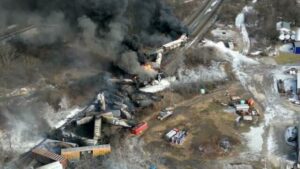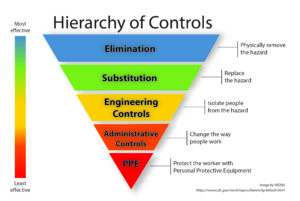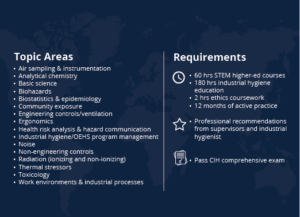
What is Industrial Hygiene?
Workplace safety and health are critical for employees and employers. Ensuring a safe work environment is crucial not only for the well-being of workers but also for the productivity and success of a business.
Industrial hygiene is the art and science of recognizing, evaluating, and controlling occupational and environmental health hazards that may cause health effects, disease, or even death.
Industrial hygiene encompasses many chemical, physical, and biological hazards. Controlling and optimizing industrial hygiene aims to prevent worker harm through recognition, evaluation, and control processes.
Recognition
Recognition requires recognizing potential hazards or threats, including chemical (most common), physical, or biological agents. Chemical agents include a wide range of harmful chemical compounds in the form of solids, liquids, gases, mists, dusts, fumes, and vapors. Physical agents include radiation, musculoskeletal and cumulative trauma disorders, noise, and thermal stress. Biological agents can include bloodborne pathogens, mold, bacteria, and viruses. Beyond recognizing the agent, good industrial hygiene identifies its nature and behavior. For example:
- Is it an acute or chronic threat?
- Will it have short-term or long-term effects?
- What chemicals are emitted, and how can they be released in the air?
Recognition also includes anticipating the potential route(s) of exposure, which can be inhalation (most common at industrial work sites), skin absorption (for some chemicals), ingestion, or injection (more common in healthcare settings).
Case In Point: Recognizing the Threat of the Vinyl Chloride Release in East Palestine, Ohio
On February 3, 2023, a 38-car train derailment led to the exposure of the toxic chemical vinyl chloride in East Palestine, Ohio. Another 12 cars were damaged by a fire. Vinyl chloride is a component of polyvinyl chloride, which can be found in various plastic products.
Recognition of the hazard in this incident involves identifying the type of hazard (toxic chemical agent vinyl chloride), whether it’s an acute or chronic threat, its short-term or long-term effects, and how it was released and may be encountered.

Photo credit: CBSNews.com
(Gene J Puskar, AP)
Type of Hazard: Toxic chemical agent (vinyl chloride)
Acute Threat: In the first few days of the incident, there was an acute threat of explosion. Chronic Threat: Pollution to the soil and water in the area and particulates in the air became prominent.
Short-Term Effects: Inhaling vinyl chloride has many short-term effects, including respiratory irritation and coughing. Pollution may result in the death of wildlife.
Long-Term Effects: Pollution can damage the environment surrounding the accidents for the foreseeable future. Vinyl chloride is also a carcinogen, which poses negative long-term effects for residents.
Recognizing potential reactions and byproducts are also important in order to assess and control potential exposures. For example, hazardous byproducts from burning vinyl chloride are many, which include hydrogen chloride, benzene and unsaturated hydrocarbons, carbon monoxide, and phosgene.
This example demonstrates recognizing hazards after a one-time train accident to provide an illustration of the general process. In industrial hygiene, potential exposures are recognized in recurring, day-to-day processes, not just major one-time accidents, to further evaluate the risk of exposures to workers and the surrounding area.
Evaluation
The evaluation component of industrial hygiene is typically where many industrial hygienists spend most of their time. This component includes evaluating the risk of exposure. The term “risk” in industrial hygiene considers the potential health effects and the exposure level. In other words, a chemical agent that has serious, irreversible health effects presents a higher risk than a chemical agent that has less serious, reversible health effects, all else remaining equal. Likewise, a work activity or process that produces a high exposure level presents a higher risk than a work activity or process that produces a lower exposure level, all else remaining equal.
An exposure assessment involves collecting informative data to qualify and quantify the risk. Ideally, collecting sampling data by monitoring exposure during the actual work activity. In some cases, data used to assess exposures may be obtained through simulated exposure studies, exposure modeling, and/or scientific literature (published and/or unpublished). Exposure assessments may also be performed prospectively (before exposure) or retrospectively (after exposure). By conducting an exposure assessment, industrial hygienists can determine how subjects are exposed to a certain hazard, what materials they are exposed to, what activities create exposure, and the extent of exposure.
Control
From the determinations and analysis performed in the recognition and evaluation components of industrial hygiene, control recommendations are made to reduce exposures determined to have an unacceptable risk.

1. Eliminate Hazardous Agent
2. Substitute for Less Hazardous Agent
3. Implement Feasible Engineering Controls: Closed Enclosures, Ventilation, Etc.
4. Provide Administrative Controls: Training & Surveillance
5. Require Use of Personal Protective Equipment (PPE)
The most effective controls at the top of the hierarchy can also be the hardest to implement in an existing process. Likewise, the least effective (PPE) may be the easiest to implement. Having a comprehensive understanding of the hazardous agents, exposure risk, and effects of exposure both in the short and long term plays a key role in control recommendations.
Becoming a Certified Industrial Hygienist
Becoming a CIH (certified industrial hygienist) requires demonstrated competencies in several areas, including sampling, engineering controls, chemistry, ergonomics, health risk assessments, toxicology, and much more. To become a CIH, one must demonstrate thorough education and experience, complete a comprehensive exam, and provide references from supervisors and colleagues.
The Importance of Industrial Hygiene
A safe and healthy work environment can significantly reduce workers’ risk of injury and illness. This leads to increased productivity, efficiency, and job satisfaction, as workers feel valued and cared for by their employers. An effective industrial hygiene program can help organizations avoid costly fines and legal issues associated with workplace hazards and injuries.
By investing in industrial hygiene programs and practices, employers can ensure the safety and health of their workers, increase productivity, reduce costs associated with workplace illness and injury, and maintain compliance with regulatory requirements.


